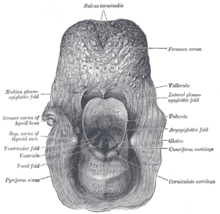glottis
The glottis (singular, ancient Greek γλωττίς glōttís , German ` ` mouthpiece of a tube '' ) anatomically refers to the vocal fold apparatus with associated control cartilages , usually with the associated glottis (medical-anatomical rima glottidis ), linguistically the glottis also refers to the glottis alone.
anatomy

Basics
For the description of speech sounds or phonation types , the width and length of the glottis in cross section are important. In most cases, schematic representations are used, which indicate the thyroid cartilage , the adjusting cartilage as well as the vocal folds (see Fig. 1).
Functional anatomy
The width of the glottis essentially depends on the positioning of the cartilage (shown as black triangles in Fig. 1). The adjusting cartilages can be brought together and moved apart, which means that the width of the glottis can be varied from a narrow gap to a triangle. The control cartilage can also perform various rotational movements and thereby influence the width of the glottis as well as the degree of tension in the vocal folds (which cannot be shown in the diagram) (see Fig. 2).

Fig. 2: Scheme of the various positions of the adjusting cartilage and vocal folds; A: glottic closure, B: phonation position , C: whisper position , D: breath position; E: breathing position or resting position; Q: deep breathing position
|
function
The schematic representation of the glottis in longitudinal section (Fig. 3) is used, among other things, to explain the aerodynamic processes involved in vocal fold vibration. The opening of the glottis from the closed position (Fig. 3 - 1) and the return to the closed state (Fig. 3 - 6) represent a cycle that is repeated during the vibration. During this cycle, the vocal folds gradually open from below (Fig. 3 - 2) due to the increasing air flow, until they finally open (Fig. 3 - 3 + 4) and allow the air to pass through. The vocal folds deformed by the pressure return to their original shape and position when the pressure drops (Fig. 3 - 5 + 6) and change the shape of the glottis in such a way that a negative pressure is created for a brief moment, which helps to protect the vocal folds to merge again. The dynamic of the pressure drop is attributed, among other things, to the Bernoulli effect . The model of the upholstered pipe is used, among other things, to represent and explain the vibration of the vocal folds.

Fig. 3: Schematic representation of the glottal cycle in the modal voice ("chest voice")
|

Fig. 4: Schematic representation of the glottal cycle in the falsetto
|
literature
- Minoru Hirano: The vocal cord during phonation. Igaku no Ayumi 80 (1968), no.10
Web links
Individual evidence
- ↑ Etymonline.com: glottis ; last accessed on April 28, 2015.
- ↑ www.dwds.de: Glottis , here online ; last viewed on May 20, 2009
